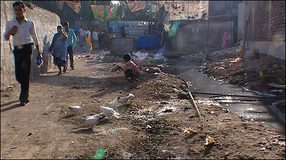Access

Access to sanitation
Many people in the developing world who lack sanitation systems take care of bodily wastes through open defecation, often directly into a plastic bag, which gets tied and then tossed away. These so-called "flying toilets" inevitably rupture, making an unhealthy mess.
While the proportion of the world's population that practice open defecation is declining, there remains an estimated 1.1 billion people in the world who defecate in the open, the majority of which live in rural areas.
Access to improved sanitation
2.6 billion people in the world also do not have access to improved sanitation. While virtually the entire developed world use improved facilities, only about half the population in developing regions have access to improved sanitation. The disparity between urban and rural areas is also striking—seven out of ten people without improved sanitation live in rural areas.
Childhood diarrhoea is closely associated with insufficient water supply, inadequate sanitation, water contaminated with communicable disease agents, and poor hygiene practices. Diarrhoea is estimated to cause 1.5 million child deaths per year, constituting about 15% of total child deaths under five in developing countries.
Many people in the developing world who lack sanitation systems take care of bodily wastes through open defecation, often directly into a plastic bag, which gets tied and then tossed away. These so-called "flying toilets" inevitably rupture, making an unhealthy mess.
While the proportion of the world's population that practice open defecation is declining, there remains an estimated 1.1 billion people in the world who defecate in the open, the majority of which live in rural areas.
Access to improved sanitation
2.6 billion people in the world also do not have access to improved sanitation. While virtually the entire developed world use improved facilities, only about half the population in developing regions have access to improved sanitation. The disparity between urban and rural areas is also striking—seven out of ten people without improved sanitation live in rural areas.
Childhood diarrhoea is closely associated with insufficient water supply, inadequate sanitation, water contaminated with communicable disease agents, and poor hygiene practices. Diarrhoea is estimated to cause 1.5 million child deaths per year, constituting about 15% of total child deaths under five in developing countries.
